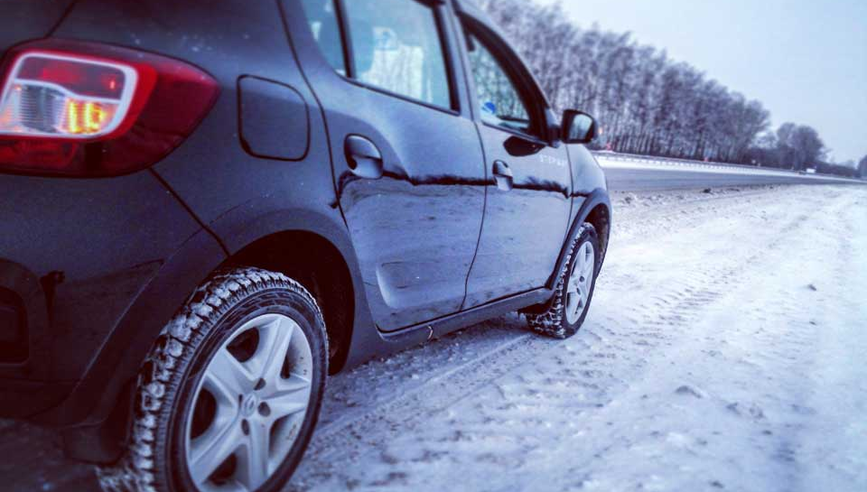The Science Behind Winter Driving


Have you ever wondered why black ice forms, how traction control works or what causes hydroplaning? Let’s take a look at the science behind some common winter driving conditions in order to better understand what leads to dangerous driving situations and help us all prepare to drive more safely this winter.
What is black ice?
Black ice is not actually black in color – it’s clear enough that you can see the road beneath it, making it appear “black.” Black ice can also be difficult to distinguish from a wet roadway and may appear wet and shiny.1 The absence of air bubbles can allow it to blend in with any surface, making it difficult to see for pedestrians on sidewalks as well as for drivers on winter roads. Fog, light freezing rain, and melting and refreezing precipitation all can cause black ice to form.
Even if the air temperature is above freezing, black ice can still develop on cooler surface temperatures and present a hazard on the roads. Moisture from vehicle exhaust can also cause black ice to form on roadways where drivers may not expect it, such as intersections where stopped vehicles may idle for brief periods of time, allowing black ice from condensate to form. If you are driving in conditions in which black ice is possible, slow down and increase your following distance. Also, know the local weather forecast. If slick road conditions are a possibility, consider waiting until conditions improve.
To learn more about safe driving in wintry driving conditions, check out our winter driving safety tips.
How does traction control work?
Slippery surfaces can be dangerous for drivers. Reduced friction between road and tires can lead to loss of traction, difficulty steering and spinning wheels. Traction control technology, now a standard feature on many newer cars, can help your wheels gain traction on wet, snowy and icy roads.
Unlike the anti-lock braking system (ABS), which is designed to activate when reducing your speed, traction control can help you maintain control while accelerating, driving up an incline or even at steady speeds. When sensors determine that a wheel is spinning, the traction control software can either reduce power or apply the brakes to that wheel in an effort to regain traction. Traction control and anti-lock brakes can be components of an electronic stability control (ESC) system, which can help detect when a skid is about to occur, and selectively apply brakes to different wheels to help you maintain control of your vehicle. Cars with anti-lock braking systems and traction control do not necessarily have an electronic stability control system, so check on your own vehicle to determine if you have this capability.
To learn more about safe driving in winter weather, read about driving in icy conditions.
What causes hydroplaning?
Hydroplaning occurs when tires ride above the road surface on a thin layer of water, reducing traction. Speed, the amount of water on the roadway, tire tread depth, tire air pressure, vehicle weight and road surface characteristics are all factors that can influence whether a vehicle is at risk of hydroplaning. It is possible for vehicles to hydroplane at speeds as low as 30 mph.
To reduce your risk of hydroplaning, avoid driving through standing water and slow down to help your tires channel water through their treads to improve traction. Watch for drivers of smaller, lighter vehicles, which may be more likely to lose control of their vehicles. In addition, during times of limited visibility such as heavy rain, remember to turn on your headlights. Doing so can also help other drivers see you. One of the most dangerous times to drive is right after it starts raining, as oils on the road can rise to the surface and contribute to slick conditions.
To learn more about driving in heavy rain and wind, check out our safety tips.
How do snow tires work?
Swapping out your “all season” tires for snow tires during the winter months may afford you better traction and performance in snowy, icy and slippery conditions. That’s because there is real science behind the design of snow tires. Snow tires are made of a softer rubber compound that will not stiffen when temperatures drop as much as all-season tires will. While it’s less durable and subject to greater wear than the stiffer all-season compounds, the softer rubber helps snow tires retain their flexibility in cold weather, an important attribute for improving traction and helping drivers stay on the road. The “sipes,” or grooves, on snow tires are designed to provide more “leading edges” on each tread block to help increase traction on slippery road surfaces.
Learn more about whether you might need snow tires during the winter months.
As winter rolls in, there is a growing possibility of finding yourself driving in less than optimum conditions. Understanding the science behind common conditions you may face, and the technology to help you deal with them, can help prepare you to stay safe on the roads.
Now that you’ve learned some winter driving tips, check in with your insurance agent to ensure you’ve got the appropriate auto coverage.
Source
¹ http://www.nhtsa.gov/people/injury/buses/updatedweb/topic_8/page6.html



